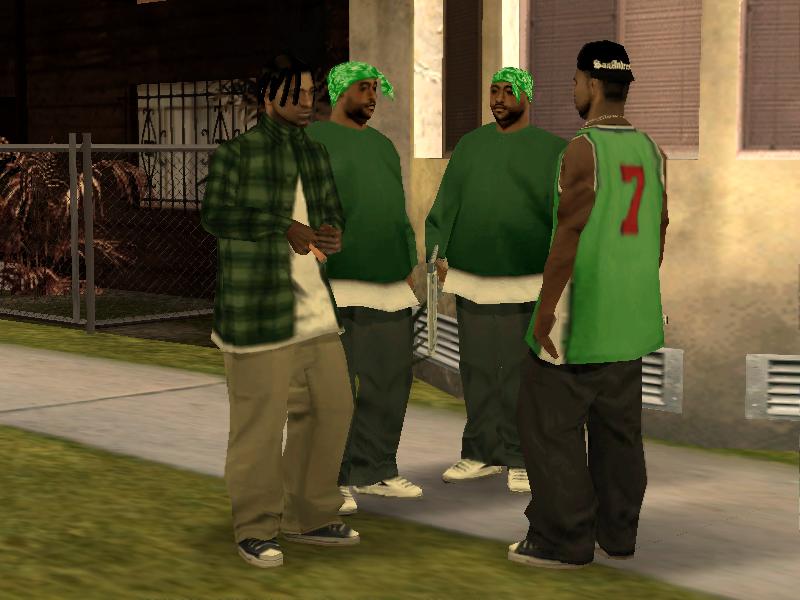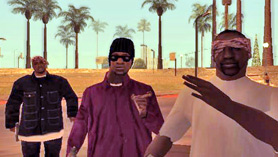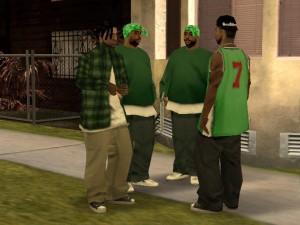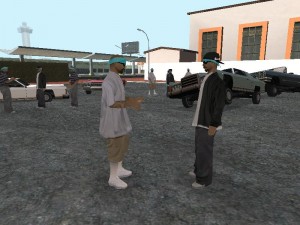Racial Stereotypes in GTA San Andreas
Grand Theft Auto San Andreas (a.k.a. GTA SA) is a 3D action/adventure video game by Rockstar Games. The game was released in 2004, and quickly became one of the most popular and best selling video games ever. The game’s storyline is that the player, Carl Johnson (a.k.a. CJ), an African American young man, returns to his home in the ghetto and joins his old gang to re-establish it and support it against the rival gang that killed his mother and friends. The player has to go through several missions, the main themes being gang wars, betrayal, police corruption, drug dealing, car theft, robbery, and establishing new businesses… As the game plot unfolds, CJ meets several key characters, some of which become his friends and guide him through missions… The game’s setting takes place in three big cities based on Los Angeles(“Los Santos” in the game),San Francisco(“San Fierro”), and Las Vegas(“Las Venturas”). Each city has its own characteristics and signs. As for the time period of the game, it is supposed to take place in the early 1990’s.
Racial stereotyping in video games is dangerous because it gives a “negative self image” for the ethnic minority youths that play these games. Racial stereotyping also gives a negative and false image to non-ethnic youths who don’t really know much about the reality of these ethnic minorities.
Besides violence, and sex, one of the most controversial things about the GTA SA is the racial stereotyping it presents. Characters in the game, being main characters, pedestrian characters, or gang members, are resembled as ethnic stereotypes. The three races that are stereotyped are African Americans, Mexicans, and Asians. These races are not only physical/visually presented as stereotypes, but are also socially presented as stereotypes because they are mainly presented as criminals, gangsters, trouble makers, drug junkies, and victims. We will now study how each of the three ethnic groups are portrayed in the game.
African Americans in the game are mainly portrayed as gangsters, poor people, and drug abusers. There are 2 black gangs in the game, the “Front Yard Ballas” and the “Grove Street Families”. The Ballas gangs are always dressed in purple colors (see fig. 1), while Grove Street gangs are always dressed in green colors. The black gangs mainly reside in the ghetto areas of Los Santos. These urban ghettos consist of small houses next to each other. The walls of the houses are dirty, and so are the streets. The paved roads look weary and you can find many cracks and dirt on them. You can also see garbage on the streets and pavements (see fig. 2, 3, 4). You can also see a lot of chaotic electric cables in these areas. All these signs connote a poor neighborhood with poor living conditions. The cars people drive in these areas are also old and dirty, signifying poverty of the social class living in those areas (see fig. 5).
There main black characters in the game are Carl “CJ” Johnson, Melvin “Big Smoke” Harris, Lance “Ryder” Wilson, Sean “Sweet” Johnson, and “Officer Tenpenny”. Notice how each one is given a nickname, connoting gangster culture. Physically, each of these characters has his own distinctive traits, but each is based on a real life black rap star or celebrity. CJ for example resembles rapper Young Maylay and famous actor Will Smith (see fig. 6). CJ starts the game dressed in a white tank top and blue jeans. This gives him a street-like look. His clothes and haircut are later fully customizable in the game, he can wear anything the player chooses; from gangster bandanas to chains to casual average clothes… and he’s also able to get tattoos.
The character Big Smoke resembles actor Clifton Powell and famous rap legend Biggie Smalls a.k.a. “Notorious B.I.G.” (see fig. 7b). Big Smoke is usually seen smoking a cigar, and is always wearing a hat and a collared shirt and baggy but relatively neat clothes, signifying that he’s financially well off. It turns out later in the game that he runs a drug factory. In figure 7a, which is one of the intro screens of the game, Big Smoke is holding a cigar in one hand and a lot of dollars in the other, and he’s looking down at the camera. This aesthetic camera angle, along with the cash, cigar, and low rider car shows Big Smoke in a position of power.
The last main character, Officer Tenpenny, is the only black cop in the game. He resembles famous boxer Evander Holyfield (see fig. 9). However, Tenpenny is a corrupt cop. His face is rugged and he’s always frowning, and he bears a mustache. His build is muscular, and he also has some tattoos on his arms. These features give him a tough, mean look.The characters Sweet and Ryder both resemble members of the famous rap group NWA (see fig. 8b). Sweet is always grinning and serious. He is muscular, and his face is rugged. He also has a beard. These features give him the tough look. He also wears a green baggy shirt and pants, and a cap, giving him a street look. Ryder on the other hand is also more specifically resembles rapper Eazy-E (see fig. 8a). This character is always wearing black sunglasses, a cap, and is always smoking a joint. He also has mustache and a goatee. The sunglasses make his character a dodgy shady one… and as the game unfolds he turns out to be a traitor. His body is slim, but his clothes are baggy, giving him a gangster-druggie look, but not a tough one. He is involved in drugs and robbery on many occasions in the game.
Black gangs in the game are made of 3 different characters repeated again and again. This fact in itself is a stereotyping of what gangsters look like. Gang members are usually seen hanging around the streets in groups of three or four (see fig. 10) reminiscent of gangster rap groups like NWA and G-Unit (fig. 11). They are usually talking and gesturing, smoking cigars, drinking beer or some alcoholic drink, checking out girls, or just engaging in a fight against the police or a rival gang (see fig. 12). The gangsters are usually holding guns or knives, but not always.
The first gangster stereotype (fig. 13) resembles famous rap legend Tupac Shakur. He is wearing a bandana tied at the forehead, baggy clothes, sneakers, and has a beard. These signs connote a street-thug look. The second gangster stereotype (fig. 14) is also wearing casual baggy clothes, he has a dreadlock haircut. The third black gangster stereotype (fig. 15) is wearing baggy pants, a basketball top, a cap worn with the rim to the back and tilted to the side, a chain with a cross, and a chain bracelet. He also has a beard. The features are typically stereotypical gangster-rapper thug looks. The Ballas gang members are very similar to the Grove Streetgangs, with the addition of one character wearing black sunglasses and a beanie hat with baggy clothes. His appearance is also that of a gangster thug.
Pedestrian characters in the game are also portrayed as negative stereotypes. One pedestrian character type (fig. 16) is usually seen sitting on sidewalks or just wandering about smoking or as he says “busy getting high”. He wears a sunhat and baggy pants, and no top. He wears a chain and bracelet chain. A similar black pedestrian type (fig. 17) wears a sports suit and has a beard. Another pedestrian is a girl (fig. 18) wearing a sports jersey and a beret like hat. She has dreadlock hair. Another pedestrian type (fig. 19) is a middle aged bald skinny man wearing casual clothes. This type is more of a casual average guy stereotype than a street thug or gangster. Yet another pedestrian type is the street bum (fig. 20) who just wanders around and lies on pavements. He wears dirty shabby clothes with scarves and gloves and a hat.
Fig. 21 shows yet another pedestrian type. This type wears a collared shirt with baggy shorts. He also wears a chain on his neck and wrist. He has a mustache and goatee. He is usually chewing gum. He also walks with a stagger. These signs make this character appear as the typical street thug and troublemaker he is intended to be.
Another black pedestrian type is the prostitute (fig. 22). She is wearing a string bikini top, tight skimpy shorts, and thigh-high leather boots. Her clothes connote that she is a prostitute. She also walks in a seductive way, which also connotes what she is.
The last type of black pedestrian is the thief or criminal (fig. 24). He wears baggy clothes, black sunglasses, and a turban-like hat. With the way he’s dressed his character instantly stands out. You can often see this character being chased by cops. This type of thief in the game is always black.Yet another black pedestrian type is the black drug dealer (fig. 23). He is always wearing a black skullcap, black vest, baggy jeans, a chain, and is usually standing with his hands crossed waiting for customers. He usually talks to anyone that passes near him to ask them if they’re interested in trying his drugs. The dealer also carries a hidden gun that he uses if threatened. Drug dealers are only found in black neighborhoods. Sometimes white drug dealers wearing hooded jackets appear instead of the black ones, but it is mostly the black ones that are loitering on the streets.
As for the Mexican stereotypes, we have to first note that there are three Mexican gangs in the game, and all three are portrayed the same way, using similar characters, with the only difference being the color of the clothes. The Mexican gangs live in sub-urban areas. The houses all look similar, they’re small, but they’re further apart than urban areas. The buildings seem slightly old and dirty (fig. 25). There are many low walls dividing certain areas, and these walls along with the building are yellowish in color. This connotes real life areas where Hispanic groups live.
The main Mexican character “Cesar Vialpando” (fig. 26), a Mexican gang leader, is portrayed as a muscular young man, with a goatee, and many tattoos. He’s usually wearing a tank top and baggy jeans. He carries a gun that he uses when needed. In fig. 26, Cesar looks laid back and is laying on a low rider car. The Mexicans in the game are portrayed as a low rider and car hydraulics loving culture, and the gang members usually drive convertible low riders and make low rider meetings (fig. 27).
Like the black gangs, Mexican gangs can be found hanging out on Mexican territories in groups of three or four. They are usually dressed in casual street baggy clothes, and wear bandanas, caps, chains, and sunglasses (fig. 28). Most of these gangsters have a beard, however, it is different than the ones the black gangsters have. All these features connote a gangster and street thug image, and the excessive use of sunglasses connotes that these people are dodgy. Like the black gangs, Mexican gangs can be seen holding guns, smoking cigars, and drinking (fig. 28). You could also occasionally see a gangster driving around with a prostitute (fig. 27b). Furthermore many of these Mexican gangsters are portrayed as pimps.
Some Mexican pedestrians, like the one in fig. 29, look very similar to the gangsters. They also wear sunglasses, and have tattoos, but this type doesn’t have a beard nor wear a bandana. This is supposed to be the average Mexican man stereotype presented in the game. A different but similar version of this pedestrian is the on in fig. 30. This type looks more like the gangsters, and is supposed to be a street thug. You can often find him creating trouble and getting into fights. A different Mexican pedestrian type is the man in fig. 31. He is old and very skinny, perhaps connoting previous drug abuse problems. His arms are all tattooed, he has thick mustache, and his clothes look cheap. He seems to be of the poor class. A different pedestrian type is the one in fig. 32. Although he’s wearing a tank top, his shorts and shoes look fancy. And he’s also wearing a fancy hat, and sunglasses. He has a thin mustache and goatee, and his hair seems to be long and braided. This type of pedestrian can often be seen buying drugs or just walking around. As for female Mexican pedestrians, they’re either portrayed as average sporty women (fig. 33), or prostitutes (fig. 34). Like the black prostates, the Mexican prostates wear clothes that connote what they are, and they also wear makeup to go along with it, and walk in a seductive way. Most of the Mexican pedestrians in the game can usually be heard cursing and using foul language in the streets. They all have a notable Mexican accent, and most of them use a few Mexican words while talking.
The third ethnic minority stereotyped in the game is the Asian minority. There are two types of Asian gangs in the game; the Chinese “Triad” or mafia (fig. 35), and the Vietnamese “Da Nang Boys” (fig. 36), a small street gang. The main Asian character “Woozie” is the leader of the Triad. He is always wearing a neat black suit and sunglasses. He has no beard. His looks connote that he is a harmless yet somewhat powerful character, and that’s exactly who he is in the game. He’s portrayed as a friendly gang leader with a sense of humor and interest in illegal car racing. He turns out to be blind later in the game. The fact that he’s blind and always relies on his best man could connote that Asians work together in groups and rely closely on each other to succeed. However this might not have been intended; the fact that he’s blind could have just been made up as a comic angle to the game storyline.
The Chinese Triad gang can be seen in groups of three or four in their territories in San Fierro. They reside far away from Black and Mexican territories. The areas they live in are modern, urban, and commercial. The city they’re found in looks new, clean, and prosperous (fig. 37). The buildings are mostly large buildings and skyscrapers. The streets they control have Asian/oriental decorations such as arches with dragon designs and monuments.
The Triads drive fast sports cars (fig. 38), and the guns they own are more advanced and powerful than the other gangs. These facts make up the stereotype that some Asian countries likeJapanandChinaare more technologically advanced than other countries. Moreover, the Triads wear neat black suits (fig. 35), and the characters have short haircuts and “Asian eyes”. They don’t have beards, but one gangster type has a neat goatee. In general they are a neat-looking mafia, and the fact that they are all dressed similarly and in one color connotes that they are a well organized unit, unlike the other gangs. They don’t wear any jewelry or chains, and are never seen smoking. You might occasionally find a Triad member drinking, and they usually always carry guns and rifles, signifying their power.
The other Asian gang however is totally opposite. Each member looks different, and they have more of a street and thug/gang look as opposed to a mafia. TheDa Nanggang are supposedly illegal immigrants, and can only be seen around the sea docks area. They usually carry guns similar to those of the black gangs. They don’t wear any chains or jewelry, and can’t be seen smoking or drinking. This makes them appear serious and threatening. The first type of these gangsters has short straight hair, a goatee, and pale yellowish skin (see fig. 39). He wears hip looking sunglasses. He also wears a unique style shirt, black pants, and shiny black shoes. He walks in a way that shows attitude. These traits give a street-like character connotation. The second type ofDa Nanggangster has a bald head and tattooed arms (see fig. 40). He wears jeans and a casual shirt with the word “army” on it. The fact that these gangsters are illegal immigrants and they’re wearing the word “army” connotes that they are challenging authority. It is as if they consider themselves the army and they want to take control of the streets. The third type ofDa Nanggangster wears cargo pants and a tight black t-shirt. His hands are tattooed, and he wears something like a long bandana on his head, giving him a rebel-like look (see fig. 41)
Asian pedestrians in the game also look neat. They look as if they’re from the middle class. They wear fancy clothes and look clean and tidy. They don’t wear jewelry or have tattoos. Two young Asian guys have straight short hair; one of them has a goatee. One wears a fancy shirt and pants (see fig. 42), and the other wears casual clothes (see fig. 43). An old Asian man wears a neat suit, making him look like a business man. A young Asian woman wears casual top and short but decent skirt. There are no Asian prostitutes in the game. Asian pedestrians are usually found driving new looking cars.
Let us now take a look at how the ethnic majority or white people are portrayed in the game. White people in the game are stereotyped as the “good people”. We don’t see any “white” gangs in the game. White pedestrians are pictured as middle to upper class people, wearing neat and clean clothes, whether fancy or casual (see fig. 44). Most white males have clear shaven beards, and finely combed hairdos. White women are portrayed wearing trendy fancy clothes.
Many of the white people are also portrayed as employees. Job like policemen and firefighter are exclusively for white people; you don’t see any black or Hispanic cops or firefighters (see fig. 45) except for officer Tenpenny… and he was corrupt. The rich areas such as Las Venturas and Mullholland (based onHollywood) are mostly inhabited by white people driving fancy cars.
So how is racial stereotyping in video games dangerous?! Kansas State University psychologist John Murray says “If Blacks and Latinos are always portrayed as the villains or as the victims who get killed often and easily, that is code for powerlessness”. Richard O. Jones says in an article that when black kids play video games where the black man is always portrayed as a criminal or a victim, the kids will develop a poor self image and would think that that’s how they would or should become when they grow older. He says “games that are being designed unconsciously include the biases, opinions and reflections of their creators”. He also says that white people see black people and Latinos as criminals, and gradually that’s how black and Latino children start to see themselves and behave accordingly. In addition to that, racial stereotyping gives a false image about these racial groups, and only shows what the majority white people stereotypically think of these races. As game producer Morgan Gray says in an MTV interview, “not everyone is Tupac, not everyone is like N.W.A.”. He also says “San Andreas gets scary because it’s basically what people think black people are”. GTA SA creators based their black stereotypes mainly on pop culture celebrity rappers, but the truth is not all black people are like that. A study conducted by Karen Dill, a psychology professor at Lenoir-Rhyne College, found that black and Latino men were “more likely to be portrayed as athletes or aggressors” in games, and Asians were often portrayed as “intellectually superior but physically inferior”.
In conclusion, GTA SA obviously contains racial stereotypes of ethnic minorities. These stereotypes give a false image to youths, especially white ones, who don’t really know the reality about these ethnic groups. It also gives a negative self image to the portrayed ethnic minority youths that play the game, and might lead them to eventually limit their aspirations in life and make them follow these negative stereotypes. Video games should be more conscious of the signs and connotations and stereotypes they use because not all their audiences are socially well aware or educated. Game producers should avoid using negative racial stereotypes, and try making their characters as diverse and realistic as possible.
Despite all we said about racial stereotyping in the game, GTA San Andreas remains and always will remain one of the BEST games of all time. And you know what… come to think of it, although racial stereotyping is bad, perhaps it just portrayed how society already is and how people already perceive their society and these ethnic groups… so instead of worrying about a video game, how about we worry about how we raise out kids and how we educate them about peace and love and tolerance instead. The important thing is: just don’t be a racist.
Here’s a link to the game’s official site: http://www.rockstargames.com/sanandreas/






